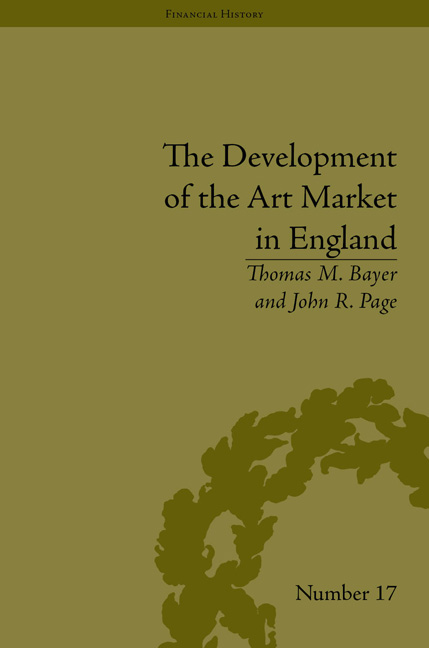Book contents
- Frontmatter
- CONTENTS
- Acknowledgements
- List of Figures and Tables
- Dedication
- Introduction
- 1 The Early Stages: From the Netherlands to Great Britain
- 2 The Commoditization of Theories of Art
- 3 The Painter as Homo Economicus
- 4 Critics and Auctions
- 5 The Evolution of Picture-Dealing
- 6 The Victorian Era
- 7 ‘Working the Oracle’: The Tools of the Trade
- 8 The Formation of a Nexus: A Story of Christie's
- 9 Commoditization and the Artist as Producer: Product Differentiation and the Domestication of Pictures
- 10 The End of the ‘Golden Age’
- 11 Postscript: A Perpetual Innovative Whirl
- Notes
- Works Cited
- Index
4 - Critics and Auctions
- Frontmatter
- CONTENTS
- Acknowledgements
- List of Figures and Tables
- Dedication
- Introduction
- 1 The Early Stages: From the Netherlands to Great Britain
- 2 The Commoditization of Theories of Art
- 3 The Painter as Homo Economicus
- 4 Critics and Auctions
- 5 The Evolution of Picture-Dealing
- 6 The Victorian Era
- 7 ‘Working the Oracle’: The Tools of the Trade
- 8 The Formation of a Nexus: A Story of Christie's
- 9 Commoditization and the Artist as Producer: Product Differentiation and the Domestication of Pictures
- 10 The End of the ‘Golden Age’
- 11 Postscript: A Perpetual Innovative Whirl
- Notes
- Works Cited
- Index
Summary
The Economics of Art Criticism
By the time painters approached the public sphere at mid-century, cultural criticism was well established in Britain. The growth of England's book industry in the seventeenth century had offered new opportunities to authors, but also to a new subgroup of writers, the literary critic. Confronted with an expanding audience, these writers recognized that their essays had to be directed towards an increasing and demographically more diverse audience. Indeed, literary criticism experienced, albeit earlier than painting, its own similar commoditization to adapt to the progressively broadening and more heterogeneous consumer base for literary works. The growing popularity of art auctions and the advent of public exhibitions of works by contemporary painters provided writers with new topics, and a new literary genre was born: popular art criticism as it is still practised today.
The first public showing of paintings in April 1760 generated little response. However, soon thereafter, journalists recognized the opportunities to write about art for a still developing audience. Initially these contributions, often solicited from the public by newspapers or periodicals, simply advertised an event together with rudimentary instructions in viewing paintings to an audience not yet conversant in matters of art. In one of the few surviving reviews of the 1760 exhibition, published in the Imperial Magazine, the author was clearly more concerned with promoting the show.
- Type
- Chapter
- Information
- The Development of the Art Market in EnglandMoney as Muse, 1730–1900, pp. 71 - 80Publisher: Pickering & ChattoFirst published in: 2014



